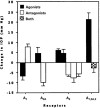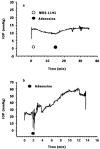A(1)-, A(2A)- and A(3)-subtype adenosine receptors modulate intraocular pressure in the mouse
- PMID: 11564641
- PMCID: PMC1572961
- DOI: 10.1038/sj.bjp.0704267
A(1)-, A(2A)- and A(3)-subtype adenosine receptors modulate intraocular pressure in the mouse
Abstract
Despite the potential importance of the mouse in studying the pharmacology of aqueous dynamics, measurement of intraocular pressure (IOP) in its very small eye has been problematic. Utilizing a novel servo-null electrophysiologic approach recently applied to the mouse, we have identified a diversity of adenosine-receptor mechanisms in modulating IOP in this species. We report the first evidence that A(3) receptors increase IOP in any species, and verify in the mouse reports with larger mammals that A(1) receptors lower and A(2A) receptors increase IOP.
Figures


Similar articles
-
Knockout of A3 adenosine receptors reduces mouse intraocular pressure.Invest Ophthalmol Vis Sci. 2002 Sep;43(9):3021-6. Invest Ophthalmol Vis Sci. 2002. PMID: 12202525
-
Adenosine receptor activation modulates intraocular pressure in rabbits.J Pharmacol Exp Ther. 1995 Apr;273(1):320-6. J Pharmacol Exp Ther. 1995. PMID: 7714784
-
Newer targets for modulation of intraocular pressure: focus on adenosine receptor signaling pathways.Expert Opin Ther Targets. 2014 May;18(5):527-39. doi: 10.1517/14728222.2014.888416. Epub 2014 Mar 1. Expert Opin Ther Targets. 2014. PMID: 24579961 Review.
-
Differential P1-purinergic modulation of human Schlemm's canal inner-wall cells.Am J Physiol Cell Physiol. 2005 Apr;288(4):C784-94. doi: 10.1152/ajpcell.00333.2004. Epub 2004 Dec 8. Am J Physiol Cell Physiol. 2005. PMID: 15590899
-
Adenosine, adenosine receptors and glaucoma: an updated overview.Biochim Biophys Acta. 2013 Apr;1830(4):2882-90. doi: 10.1016/j.bbagen.2013.01.005. Epub 2013 Jan 15. Biochim Biophys Acta. 2013. PMID: 23328492 Review.
Cited by
-
A Randomized Phase 1 Dose Escalation Study to Evaluate Safety, Tolerability, and Pharmacokinetics of Trabodenoson in Healthy Adult Volunteers.J Ocul Pharmacol Ther. 2016 Oct;32(8):548-554. doi: 10.1089/jop.2015.0147. Epub 2016 Apr 5. J Ocul Pharmacol Ther. 2016. PMID: 27046445 Free PMC article. Clinical Trial.
-
Purinergic regulation of epithelial transport.J Physiol. 2004 Mar 1;555(Pt 2):311-21. doi: 10.1113/jphysiol.2003.056697. Epub 2003 Dec 23. J Physiol. 2004. PMID: 14694149 Free PMC article. Review.
-
Topical treatment of glaucoma: established and emerging pharmacology.Expert Opin Pharmacother. 2017 Jun;18(9):885-898. doi: 10.1080/14656566.2017.1328498. Expert Opin Pharmacother. 2017. PMID: 28480761 Free PMC article. Review.
-
NUCLEOSIDE PRODRUGS OF A3 ADENOSINE RECEPTOR AGONISTS AND ANTAGONISTS.Collect Czechoslov Chem Commun. 2006;71(6):912-928. doi: 10.1135/cccc20060912. Collect Czechoslov Chem Commun. 2006. PMID: 34815583 Free PMC article.
-
Discovery of Molecular Therapeutics for Glaucoma: Challenges, Successes, and Promising Directions.J Med Chem. 2016 Feb 11;59(3):788-809. doi: 10.1021/acs.jmedchem.5b00828. Epub 2015 Sep 25. J Med Chem. 2016. PMID: 26356532 Free PMC article. Review.
References
-
- ASSEFF C.F., WEISMAN R.L., PODOS S.M., BECKER B. Ocular penetration of pilocarpine in primates. Am. J. Ophthalmol. 1973;75:212–215. - PubMed
-
- AVILA M.Y., CARRÉ D.A., STONE R.A., CIVAN M.M. Reliable measurement of mouse intraocular pressure by a servo-null micropipette system. Invest. Ophthalmol. Vis. Sci. 2001;42:1841–1846. - PubMed
-
- CARRÉ D.A., MITCHELL C.H., PETERSON-YANTORNO K., COCA-PRADOS M., CIVAN M.M. Adenosine activates Cl− channels of nonpigmented ciliary epithelial cells. Am. J. Physiol. 1997;273:C1354–1361. - PubMed
-
- CARRÉ D.A., MITCHELL C.H., PETERSON-YANTORNO K., COCA-PRADOS M., CIVAN M.M. Functional similarity of A3-adenosine and swelling-activated Cl− channels in nonpigmented ciliary epithelial cells. Am. J. Physiol. 2000;279:C440–C451. - PubMed
-
- CROSSON C.E. Adenosine receptor activation modulates introcular pressure in rabbits. J. Pharmacol. Exp. Ther. 1995;273:320–326. - PubMed
Publication types
MeSH terms
Substances
Grants and funding
LinkOut - more resources
Full Text Sources
Other Literature Sources

